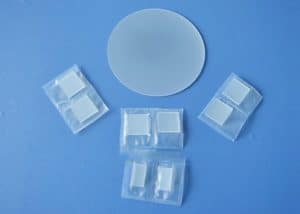
MgAl2O4 Substrate (Spinel)
Magnesium Aluminate (MgAl2O4 or spinel) single crystalsare widely used for bulk acoustic wave and microwave devices and fast IC epitaxial substrates. MgAl2O4 is an attractive material for uses in a wide range of optical, electronic and structural applications including windows and lenses, which require excellent transmission from the visible through to the mid IR. Theoretical transmission is very uniform and approaches 87% between 0.3 to 5 microns. Transmission characteristics rival that of ALON and sapphire in the mid-wave IR, making it especially attractive for the ever-increasing performance requirements of current and next-generation IR imaging systems. MgAl2O4 is a relatively low-cost substrate material, which has been successfully applied to the growth of high quality GaN films. MgAl2O4 is cleaved on the (100) plane. GaN LD cavities have been obtained by simply cleaving MgAl2O4 substrates along the (100) direction, which will also work well for ZnO. MgAl2O4 crystal is very difficult to grow, due to the difficulty in maintaining a single phase structure.
Features
1 ) Good optical, chemical and thermal properties
2 ) Good high temperature properties
3 ) Stable physical performance
Applications
1 ) Bulk acoustic wave devices
2 ) Microwave devices
3 ) Fast IC epitaxial substrates
Specifications
Materials | MgAl2O4 (Spinel) |
Orientation | [100] or [100] or [111] < ±0.5° |
Surface Finish | Single side polished (SSP) or Double sides polished (DSP) |
Polished Side Roughness | < 0.5 nm |
Typical Size | 10 x 10 x 0.5 mm, φ50.8 x 0.5 mm etc. |
Dimension Tolerance | ±0.1 mm or better |
Thickness Tolerance | ±0.05 mm or better |
Maximum Size | Diameter 2 inches |
Properties
Chemical Formula | MgAl2O4 |
Crystal Structure | Cubic |
Lattice Parameters | a = 8.083 Å |
Melting Point | 2130 ℃ |
Density | 3.60 g/cm3 |
Transmission Range | 0.21~5.3 µm |
Refractive Index | 1.71 |
Hardness | 7.5~8 Mohs |
Thermal Expansion Coefficient | 7.45 × 10^-6/K |
Phase Velocity | 6500 m/s at (100) shear wave |
Propagation Loss | 6.5 dB/ms |
Specific Heat | 0.59 W.s/g/K |
Dielectric Constants | 9.65 |
